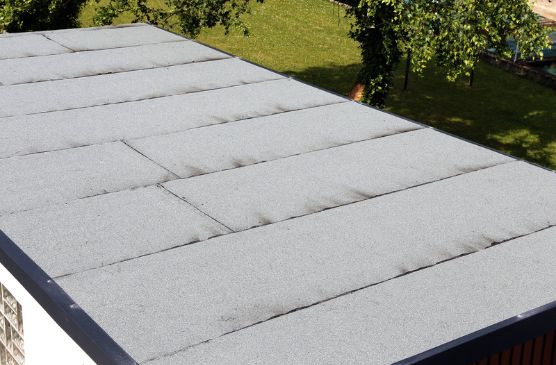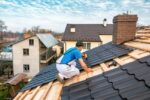This Post may contain Affiliate Links. Please read our Disclosure for legal jargon.
Let’s face it; our roofs are the unsung heroes of our homes and buildings. They shelter us from the elements and provide a solid foundation for the entire structure. One critical aspect of roofing systems is the membrane, a protective layer that ensures long-lasting performance and durability. Today, we’ll delve into the world of roofing membranes, exploring their importance and how to choose the right one for your project.
With so many roofing membrane options available, selecting the perfect one for your project might seem overwhelming. Fret not, my friend! We’ll help you choose the best fit for your needs by comparing their key features and differences.
Outline
10 Different Types of Roofing Membranes
1. EPDM: The Economical Choice
Ethylene propylene diene monomer (EPDM) is a cost-effective thermoset membrane known for its flexibility, resilience, and longevity. EPDM can withstand temperature extremes, making it suitable for various climates. Additionally, it is resistant to punctures and tears, contributing to its durability. They can last up to 30 years with proper maintenance.
Suitable for: Industrial facilities, warehouses, and commercial buildings requiring a cost-effective, durable, and long-lasting roofing solution.
2. Neoprene: The Chemical-Resistant Solution
Neoprene, a chloroprene-based synthetic rubber, offers superb chemical resistance and dimensional stability. Which makes it ideal for applications with exposure to harsh chemicals or pollutants. Neoprene’s high tensile strength and resistance to tearing contribute to its long service life.
Suitable for: Facilities that need a chemically resistant roofing solution, such as chemical processing plants or factories with harsh emissions.
3. PVC: The Versatile and Eco-Friendly Option
Polyvinyl chloride (PVC) roofing membranes are lightweight, versatile, and environmentally friendly. PVC offers excellent resistance to chemicals, punctures, and UV radiation. It can be easily recycled at the end of its lifecycle, making it a sustainable choice.
Suitable for: Retail centers, hospitals, schools, and commercial buildings looking for an energy-efficient, durable, and eco-friendly roofing option.
4. TPO: Energy Efficiency Meets Durability
Thermoplastic olefin (TPO) combines EPDM’s durability with PVC’s heat-weldability. TPO membranes are prized for their energy efficiency and durability. They are often white, reflecting sunlight and reducing heat absorption, thus lowering cooling costs in the building. TPOs also resist punctures, tears, and UV degradation, ensuring long-term performance.
Suitable for: Facilities seeking an energy-efficient and durable roofing solution with good resistance to UV exposure, such as office buildings, shopping malls, or industrial complexes.
5. KEE: The Long-Lasting Investment
Ketone ethylene ester (KEE) is a high-performance thermoplastic membrane designed for longevity. It offers outstanding chemical resistance, flexibility, and UV stability. Its long-lasting performance and low maintenance requirements make it an excellent long-term investment for demanding applications.
Suitable for: Buildings requiring a long-lasting investment with excellent chemical resistance, UV stability, and durability, such as manufacturing facilities or storage warehouses.
6. Modified Bitumen Roofing Membranes
Modified bitumen (MB) membranes are asphalt-based, and reinforced with either polyester or fiberglass. They offer excellent waterproofing and durability. They combine the benefits of traditional built-up roofing (BUR) with the advantages of single-ply membranes.
These systems are composed of asphalt modified with either styrene-butadiene-styrene (SBS) or atactic polypropylene (APP), reinforced with polyester or fiberglass.
1. SBS: Enhanced Flexibility for Extreme Conditions
SBS-modified bitumen membranes provide exceptional flexibility, even at low temperatures. This characteristic makes them suitable for climates with extreme temperature fluctuations, ensuring reliable performance in challenging conditions.
Suitable for: Buildings in extreme temperature environments, such as ski resorts, or facilities that require flexibility and resilience to thermal cycling, like commercial buildings or schools.
2. APP: Heat Resistance with a Modern Twist
APP-modified bitumen membranes offer excellent heat resistance, making them ideal for hot climates or roofs with significant sun exposure. These membranes are known for their durability and resistance to UV degradation, contributing to their long service life.
Suitable for: Commercial facilities or industrial buildings that need a roofing solution with heat resistance and strong waterproofing properties, such as factories or processing plants.
7. Built-Up Roofing (BUR) Membranes
Built-up roofing (BUR) systems, known as “tar and gravel” roofs, have existed for centuries. They consist of multiple layers of bitumen and reinforcing fabrics, topped with a layer of aggregate, such as gravel. BUR membranes offer excellent waterproofing and durability.
Suitable for: Low-slope commercial and industrial buildings that require a traditional, time-tested roofing solution with strong resistance to weather and wear.
Fiberglass Reinforcements: A Stronger Alternative
Fiberglass reinforcements in BUR systems offer improved strength, dimensional stability, and puncture resistance. Using fiberglass mats instead of traditional felt can increase the longevity and performance of a BUR system, making it an attractive option for commercial and industrial applications.
Suitable for: Facilities that need a robust and durable roofing system with added strength, such as manufacturing plants, warehouses, or commercial buildings.
8. Spray Polyurethane Foam (SPF) Roofing Membranes
Spray polyurethane foam (SPF) roofing membranes create a seamless, self-adhering barrier that conforms to the shape of the roof. SPF’s seamless nature eliminates the potential for leaks at seams, while its strong adhesion ensures a secure bond with the substrate.
Additionally, the seamless nature of SPF minimizes thermal bridging, further enhancing insulation performance. However, SPF roofing may not be suitable for all climates or roof types.
In regions with extreme temperature fluctuations, the expansion and contraction of the foam may cause cracks over time. Moreover, some roof types, such as those with excessive ponding water, may not be compatible with SPF systems.
Suitable for: Flat or low-sloped roofs in commercial or industrial buildings, including warehouses and manufacturing plants, that require excellent insulation, energy efficiency,
9. Liquid-Applied Roofing Membranes
These membranes are typically applied as a liquid coating that cures to form a seamless, waterproof, and flexible layer over the existing roof surface. Liquid-applied roofing membranes offer a range of benefits, including ease of application, versatility, and the ability to conform to complex or irregular roof surfaces.
Here is an overview of some common types of liquid-applied roofing membranes and their respective benefits:
1. Acrylic Roof Coatings: The Budget-Friendly Option
Acrylic roof coatings provide an economical option for extending the life of an existing roof or enhancing the performance of a new roofing system. These water-based coatings offer UV protection, weather resistance, and improved energy efficiency, making them an attractive choice for budget-conscious projects.
Suitable for: Commercial buildings, warehouses, and retail facilities seeking an affordable solution to improve energy efficiency and extend the life of their existing roof.
2. Silicone Roof Coatings: The Ultimate in Weather Resistance
Silicone roof coatings are renowned for their exceptional weather resistance, making them suitable for regions with heavy rain, high humidity, or extreme temperature fluctuations. They also provide excellent UV protection and can help reduce energy costs by reflecting solar radiation.
Suitable for: Buildings in areas with extreme weather conditions, such as high heat or heavy rainfall, including industrial facilities, hospitals, and educational institutions.
3. Polyurethane Roof Coatings: The High-Performance Solution
Polyurethane roof coatings offer superior durability, puncture resistance, and adhesion compared to acrylic and silicone coatings. These high-performance coatings can provide additional strength and protection to a roofing system, making them an ideal choice for demanding applications.
Suitable for: Structures requiring excellent durability and resistance to foot traffic or punctures, such as shopping centers, hotels, or residential apartment complexes.
4. Hybrid Roof Coatings: Combining the Best of Both Worlds
Hybrid roof coatings blend the best attributes of acrylic, silicone, and polyurethane coatings to create a product with exceptional performance characteristics. These coatings can offer improved adhesion, UV resistance, weather resistance, and energy efficiency, making them a versatile option for various roofing applications.
Suitable for: Buildings that require a combination of excellent weather resistance and durability, such as mixed-use developments or facilities with varying roof substrates.
10. Composite Roofing Membranes: The All-in-One Solution
Composite roofing membranes combine the benefits of multiple materials into a single, high-performance product. These systems often incorporate layers of insulation, waterproofing, and weather-resistant materials, providing a comprehensive roofing solution that simplifies installation and maintenance.
Suitable for: Facilities requiring a high-performance, all-in-one roofing solution, such as historical buildings, commercial facilities, and manufacturing plants.
Factors to Consider When Choosing a Roofing Membrane
1. Climate and Weather Conditions
When selecting a roofing membrane, consider the local climate and weather conditions. Membranes with high UV resistance are crucial in sunny regions, while those with excellent waterproofing and cold-weather flexibility are essential in wet or cold climates.
2. Roof Size and Complexity
The size and complexity of a roof can also influence the choice of roofing membrane. Large or complex roofs may require materials that are easy to install and can accommodate unique architectural features.
For instance, single-ply membranes may be more suitable for large, flat roofs, while spray-applied or liquid coatings might be ideal for roofs with intricate details and penetrations.
3. Building Usage and Occupancy
Consider the building’s usage and occupancy when selecting a roofing membrane. Commercial and industrial buildings may require membranes with enhanced chemical resistance or load-bearing capacity, while residential buildings might prioritize aesthetics and energy efficiency.
4. Budget and Long-Term Costs
Budget and long-term costs should be factored into the decision-making process. While some roofing membranes may have lower upfront costs, they could require more frequent maintenance or have shorter lifespans, ultimately increasing overall expenditures. Consider the life cycle costs, including maintenance and energy savings, to make a well-informed decision.
After learning about different roofing membranes, think about what your project needs. Talk to experts to help you choose the right one, ensuring it’s strong, works well, and looks good for your building.


